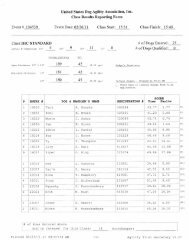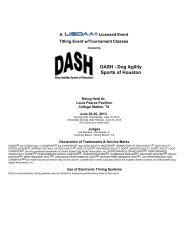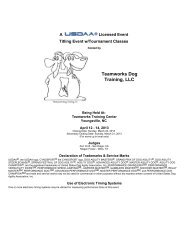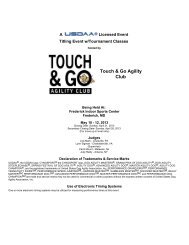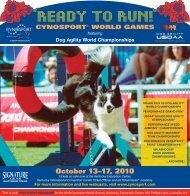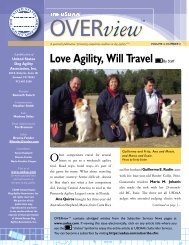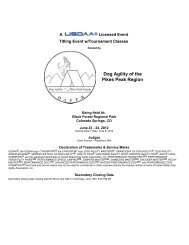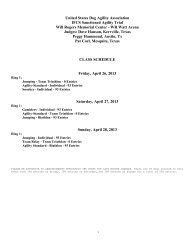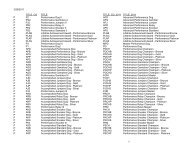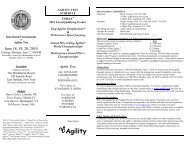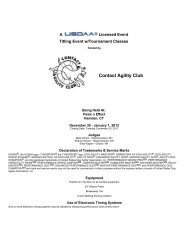Sanctioned Agility Tests, Matches & Events (updated 5/25 ... - USDAA
Sanctioned Agility Tests, Matches & Events (updated 5/25 ... - USDAA
Sanctioned Agility Tests, Matches & Events (updated 5/25 ... - USDAA
You also want an ePaper? Increase the reach of your titles
YUMPU automatically turns print PDFs into web optimized ePapers that Google loves.
No training seminars or practice sessions, other than regularly scheduled classes at the facility,shall be held at the event site one day prior to or during the event without written <strong>USDAA</strong>approval. <strong>Sanctioned</strong> matches, Junior Handler and Intro Program classes are exempt from thislimitation.SECTION 2.6—JUDGES & STEWARDSA class shall be conducted by one judge and several stewards under the judge’s direction. At aminimum each ring of operation should have a timer, scribe, gate steward, scorekeeper, andtwo to four ring stewards; course builders can generally service more than one ring at anevent.A judge shall not be allowed to compete in the event on a day that they are scheduled to judgewithout <strong>USDAA</strong> approval. Primary stewards (i.e., scribe, timekeeper and scorekeeper) shall notbe permitted to compete in a class for which they serve as stewards. For this purpose, a classis defined as a competition for which awards are being offered. (For example, a class would bea jump height grouping in a class if placements are made only by jump height; in Snooker, iftwo height classes are combined pursuant to rules set forth in Chapter 6, the combined class isconsidered a single class for this purpose). Only individuals who are listed on the “ApprovedJudges List” evidencing that they have fulfilled the <strong>USDAA</strong> requirements for judges (seeAppendix B) shall be permitted to judge at a sanctioned test or event pursuant to guidelinesestablished by the <strong>USDAA</strong> Rules & Regulations Board, except as provided in the JuniorHandler or Intro Programs (see Chapters 8 & 10), or otherwise with <strong>USDAA</strong> written approval.The judge shall be solely responsible for designing the course, measuring the course distance,establishing the standard course time, measuring dogs and scoring the performance. Thejudge shall consult with the Event Secretary in determining whether fault limits are to be utilized.When the secretary shall indicate that fault limits have been considered in establishingthe class schedule, the judge shall utilize fault limits no less stringent as those assumed in settingthe class schedule. Where the secretary indicates that fault limits were not anticipated, thejudge may apply (at their discretion) reasonable fault limits in exercising their duties pursuant toSections 3.3 and 3.4 of these regulations. While the test secretary or Organizing Committeeare responsible for scheduling the classes and number of rounds per day, the judge is responsiblefor maintaining the schedule and maintaining general efficiency of ring operations.The judge shall be responsible for building of the course to assure that the course is presentedas designed and as approved by the course reviewer. In the event of unexpected circumstancesat an event, such that approval of a needed change cannot be reviewed and approvedby a reviewer (e.g., different ring dimensions or unanticipated obstructions or other hazardswithin the ring area), the judge is empowered to modify the course to the extent necessary toconduct the class in a safe manner, while retaining the principal elements of the originaldesign. Should an obstacle fail and cannot be repaired promptly, or weather should make anobstacle unsafe or fail, the judge is empowered to substitute an obstacle of similar characteristicsif possible to preserve the integrity of the course. The judge must submit a revised coursediagram with an explanation for the change with their Event Judge’s Report, if any changes aremade to the course as previously approved.The judge shall designate stewards to serve as timekeeper and scribe for a class, but thejudge alone shall observe and signal course faults. The judge’s decision on scoring shall befinal. Use of video or other means of instant replay shall not be utilized for the determination ofcourse faults, except as may be provided in an official <strong>USDAA</strong> written policy statement.However, should time be lost on a round due to timekeeper error or clock failure, the judgeshall first determine if any objective measure of the actual performance time can be determinedthrough video. Absent such objective determination, the judge may call for a re-run of the roundfor time only. Any course faults incurred on the first run of the course (or partial run, if a run ishalted before it is finished) shall be remain as part of the competitor’s score, and the competitorshall seek to run the course in a similar style, with the judge adjusting the time for any differencesin the performance as deemed necessary to approximate time.The judge shall hold a competitor’s briefing prior to the commencement of each class, unlessdetailed briefing notes have been set forth in writing and posted along with a copy of theUnited States Dog <strong>Agility</strong> Association, Inc.17



